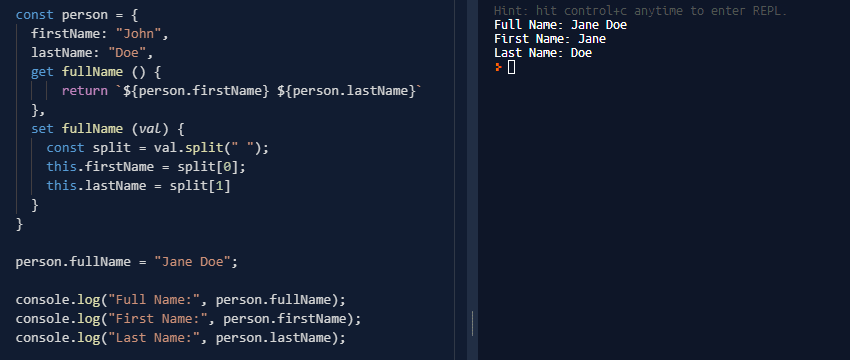Suppose we have a JavaScript Object, as we know a JavaScript object consists key-value pair. Now, there can be multiple instances where we need to pass values to the object from the outside and need to change the object value accordingly or there can also be cases where we don't want to change the key value from outside of an object. This is where the JavaScript Getter and Setter comes in.
const person = {
firstName: "John",
lastName: "Doe"
}
Here, we're assuming that we have an object that has two key-value pairs, firstName, and lastName. Now, if we want to show the full name of the person we can use either one of the way shown below,
We can console.log the full name outside the object using concatenation or using template literals, i.e,
console.log(person.firstName + " " + person.lastName); //John Doe
Or
console.log(`${person.firstName} ${person.lastName}`); //John Doe
If we want to console.log the full name at multiple places of our code, then we have to paste the same code multiple times. Which is against our DRY(Don't Repeat Yourself) rule. Another way can be creating a method for the object and calling the method whenever we want to get the full name.
const person = {
firstName: "John",
lastName: "Doe",
fullName () {
return `${person.firstName} ${person.lastName}` //John Doe
}
}
We can now call the method with
console.log(person.fullName()); //John Doe
If we want to get the value by calling the method like a property of the object, not like a regular function call, we need to use the getter method here. So, the code will be,
get fullName () {
return `${person.firstName} ${person.lastName}` //John Doe
}
The get keyword in front of the method name is important. Now, we can call fullName using person.fullName only. We don't have to add the extra braces at the end. Moreover, now we can't change the value of fullName from the outside.
If we try to set the fullName from outside of the object, we will not get an error, rather it'll show the value set inside the object.
Suppose we want pass the fullName value from outside of the object and want to set the firstName and lastName value according to the fullName value passed. If we try to initialize it using person.fullName = "Jane Doe"; it'll not work. Here comes the setter method. Let's check an example,
set fullName (val) {
const split = val.split(" ");
this.firstName = split[0];
this.lastName = split[1]
}
So, we're getting a value from the val argument and then splitting it into parts at places where the value has spaces using the JavaScript split() method. The split() method returns an array. We're assigning the first element of the array to the firstName key and the second element of the array to the lastName key.
Now we can pass a value to the fullName method and set firstName and lastName values accordingly. Both this get and set method can be achieved with multiple functions which will be more simple, but that won't be a robust solution.
The Full Code 🚀
const person = {
firstName: "John",
lastName: "Doe",
get fullName () {
return `${person.firstName} ${person.lastName}`
},
set fullName (val) {
const split = val.split(" ");
this.firstName = split[0];
this.lastName = split[1]
}
}
Why use Getter and Setter? 🐲
In object-oriented languages, an important concept is data hiding. Usually, classes have access modifiers like public/private which restricts the exposure of the members. One of the most important uses of Getter and Setter is to expose the functions more safely. For example, if we set only the get method, the value of the member can never be changed from the outside of the class.
To learn about it in more depth, check this beautiful article here.
Originally Posted at hashnode






Top comments (13)
Good post nemo
Thanks. 😄
As a fellow JS Dev, I enjoyed the intro to getters and setter. Keep up the good work 💪🏽
Thanks for your kind words. 🥰
Thanks for explaining in such an awesome way.
😊
Good post!
Thanks. ☺
Made it very simple, well explained. Thanks for the great post :)
Glad you liked it. 😀
Couldn't understand it better than that.. thank you Cpt Nemo
Glad it helped. 🥰
Thanks. It really helped